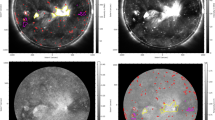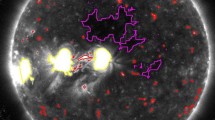Abstract
The magnetic field changes the radiative output of the Sun and is the main source for all the solar surface features. To study the role of the underlying photospheric magnetic field in relation to emission features observed in the solar corona, we have used the full-disk soft X-ray images from Hinode/X-Ray Telescope (Hinode/XRT) and the magnetograms obtained from the Helioseismic and Magnetic Imager (HMI) on board the Solar Dynamics Observatory (SDO) for a period of about 13 years (May 2010 – June 2023), which covers Solar Cycle 24 and the ascending phase of Solar Cycle 25. A sophisticated and established algorithm developed in Python is applied to the X-ray observations from Hinode/XRT to segment the different coronal features by creating segmentation maps of the active regions (ARs), coronal holes (CHs), background regions (BGs), and X-ray bright points (XBPs). Further, these maps have been applied to the full-disk (FD) line-of-sight (LOS) magnetograms from HMI to isolate the X-ray coronal features and photospheric magnetic counterparts, respectively. We computed full-disk and featurewise averages of X-ray intensity and LOS magnetic field (MF) over ARs, CHs, BGs, XBPs, and FD regions. Variations in the quantities resulting from the segmentation, namely the mean intensity, temperature from the filter ratio method, and the unsigned magnetic field of ARs, CHs, BGs, XBPs, and FD regions, are intercompared and compared with the sunspot number (SSN). We find that the X-ray intensity and temperature over ARs, CHs, BGs, XBPs, and FD regions are well correlated with the underlying magnetic field. We discuss the intensity, temperature, and magnetic field variations of the full-disk corona and of all the features. The time series plots of the unsigned magnetic field of the full disk and all the features show magnetic field fluctuations synchronized with the solar cycle (sunspot number). Although the magnetic field of all features varies, the mean, spatially smoothed magnitude of the magnetic field values estimated for the whole observed period of the full disk is around 8.9 ± 2.60 G, active regions (ARs) are around 34.4 ± 18.42 G, whereas BGs, CHs, and XBPs are 7.7 ± 1.72 G, 6.6 ± 1.04 G, and 15.62 ± 8.76 G, respectively. In addition, we find that the mean magnetic field contribution of the background regions (BGs) is around 85\(\%\), whereas ARs, CHs, and XBPs are 11\(\%\), 2\(\%\), and 2\(\%\), respectively, to the average magnetic field of the full disk. The magnetic field time series of all the features suggest that the features show a high variability in their magnetic field and the fluctuations in magnetic field are correlated to fluctuations in intensity and temperature, suggesting that the magnetic field is important in producing different emission features, which are associated with different intensity and temperature values. The magnetic field is responsible for the heating rate of the emission features, which are highly variable on solar cycle timescales. We conclude from the full-disk intensity-temperature-magnetogram analysis that the magnetic field plays a crucial role in driving the different brightenings, emissions, and temperature and heating of the corona at the sites of these magnetic features. In this study, we demonstrate that the segmented coronal features observed in the soft X-ray wavelength can be used as proxies to isolate the corresponding underlying magnetic structures.









Similar content being viewed by others
Data Availability
The daily Hinode / XRT full-disk soft X-ray images were downloaded from https://solar.physics.montana.edu/HINODE/XRT/SCIA/synop_images/syncmp_FITS/ for the period covering Solar Cycle 24 and ascending phase of Solar Cycle 25. The daily SDO/HMI full-disk LOS magnetograms are downloaded from http://jsoc.stanford.edu/HMI/Magnetograms.html. The sunspot number (SSN) data come from https://www.sidc.be/SILSO/datafiles. The final segmented images and time series database for the period covering Solar Cycle 24 and the ascending phase of Solar Cycle 25 will be made available to the public at https://hinode.isee.nagoya-u.ac.jp/xrt_seg/.
References
Adithya, H.N., Kariyappa, R., Shinsuke, I., Kanya, K., Zender, J., Damé, L., Gabriel, G., DeLuca, E., Weber, M.: 2021, Solar soft X-ray irradiance variability, I: segmentation of Hinode/XRT full-disk images and comparison with GOES (1 – 8 Å) X-ray flux. Solar Phys. 296, 71. DOI. ADS.
Adithya, H.N., Kariyappa, R., Kusano, K., Masuda, S., Imada, S., Zender, J., Damé, L., Manjunath, H., DeLuca, E., Weber, M.: 2023, Solar soft X-ray irradiance variability, II: temperature variations of coronal X-ray features. Solar Phys. 298, 99. DOI. ADS.
Beaudoin, P., Simard, C., Cossette, J.-F., Charbonneau, P.: 2016, Double dynamo signatures in a global MHD simulation and mean-field dynamos. Astrophys. J. 826, 138. DOI. ADS.
BenMoussa, A., Gissot, S., Schühle, U., Del Zanna, G., Auchère, F., Mekaoui, S., Jones, A.R., Walton, D., Eyles, C.J., Thuillier, G., Seaton, D., Dammasch, I.E., Cessateur, G., Meftah, M., Andretta, V., Berghmans, D., Bewsher, D., Bolsée, D., Bradley, L., Brown, D.S., Chamberlin, P.C., Dewitte, S., Didkovsky, L.V., Dominique, M., Eparvier, F.G., Foujols, T., Gillotay, D., Giordanengo, B., Halain, J.P., Hock, R.A., Irbah, A., Jeppesen, C., Judge, D.L., Kretzschmar, M., McMullin, D.R., Nicula, B., Schmutz, W., Ucker, G., Wieman, S., Woodraska, D., Woods, T.N.: 2013, On-orbit degradation of solar instruments. Solar Phys. 288, 389. DOI. ADS.
Couvidat, S., Schou, J., Hoeksema, J.T., Bogart, R.S., Bush, R.I., Duvall, T.L., Liu, Y., Norton, A.A., Scherrer, P.H.: 2016, Observables processing for the helioseismic and magnetic imager instrument on the solar dynamics observatory. Solar Phys. 291, 1887. DOI. ADS.
Ermolli, I., Shibasaki, K., Tlatov, A., van Driel-Gesztelyi, L.: 2014, Solar cycle indices from the photosphere to the corona: measurements and underlying physics. Space Sci. Rev. 186, 105. DOI. ADS.
Fletcher, S.T., Broomhall, A.-M., Salabert, D., Basu, S., Chaplin, W.J., Elsworth, Y., Garcia, R.A., New, R.: 2010, A seismic signature of a second dynamo? Astrophys. J. Lett. 718, L19. DOI. ADS.
Golub, L., Deluca, E., Austin, G., Bookbinder, J., Caldwell, D., Cheimets, P., Cirtain, J., Cosmo, M., Reid, P., Sette, A., Weber, M., Sakao, T., Kano, R., Shibasaki, K., Hara, H., Tsuneta, S., Kumagai, K., Tamura, T., Shimojo, M., McCracken, J., Carpenter, J., Haight, H., Siler, R., Wright, E., Tucker, J., Rutledge, H., Barbera, M., Peres, G., Varisco, S.: 2007, The X-ray telescope (XRT) for the Hinode mission. Solar Phys. 243, 63. DOI. ADS.
Hoeksema, J.T., Liu, Y., Hayashi, K., Sun, X., Schou, J., Couvidat, S., Norton, A., Bobra, M., Centeno, R., Leka, K.D., Barnes, G., Turmon, M.: 2014, The Helioseismic and Magnetic Imager (HMI) vector magnetic field pipeline: overview and performance. Solar Phys. 289, 3483. DOI. ADS.
Kariyappa, R., Pap, J.M.: 1996, Contribution of chromospheric features to UV irradiance variability from spatially-resolved CA II K spectroheliograms. Solar Phys. 167, 115. DOI. ADS.
Klimchuk, J.A.: 2006, Summary of JD3: solar active regions and 3D magnetic structure. In: IAU Joint Discussion, IAU Joint Discussion 26, 57. ADS.
Kosugi, T., Matsuzaki, K., Sakao, T., Shimizu, T., Sone, Y., Tachikawa, S., Hashimoto, T., Minesugi, K., Ohnishi, A., Yamada, T., Tsuneta, S., Hara, H., Ichimoto, K., Suematsu, Y., Shimojo, M., Watanabe, T., Shimada, S., Davis, J.M., Hill, L.D., Owens, J.K., Title, A.M., Culhane, J.L., Harra, L.K., Doschek, G.A., Golub, L.: 2007, The Hinode (solar-B) mission: an overview. Solar Phys. 243, 3. DOI. ADS.
Kumara, S.T., Kariyappa, R., Zender, J.J., Giono, G., Delouille, V., Chitta, L.P., Damé, L., Hochedez, J.-F., Verbeeck, C., Mampaey, B., Doddamani, V.H.: 2014, Segmentation of coronal features to understand the solar EUV and UV irradiance variability. Astron. Astrophys. 561, A9. DOI. ADS.
Morgan, H., Taroyan, Y.: 2017, Global conditions in the solar corona from 2010 to 2017. Sci. Adv. 3, e1602056. DOI. ADS.
Pevtsov, A.A., Fisher, G.H., Acton, L.W., Longcope, D.W., Johns-Krull, C.M., Kankelborg, C.C., Metcalf, T.R.: 2003, The relationship between X-ray radiance and magnetic flux. Astrophys. J. 598, 1387. DOI. ADS.
Skumanich, A., Smythe, C., Frazier, E.N.: 1975, On the statistical desription of inhomogeneities in the quiet solar atmosphere. I. Linear regression analysis and absolute calibration of multichannel observations of the Ca+ emission network. Astrophys. J. 200, 747. DOI. ADS.
Takeda, A., Yoshimura, K., Saar, S.H.: 2016, The Hinode/XRT full-sun image corrections and the improved synoptic composite image archive. Solar Phys. 291, 317. DOI. ADS.
Zender, J.J., Kariyappa, R., Giono, G., Bergmann, M., Delouille, V., Damé, L., Hochedez, J.-F., Kumara, S.T.: 2017, Segmentation of photospheric magnetic elements corresponding to coronal features to understand the EUV and UV irradiance variability. Astron. Astrophys. 605, A41. DOI. ADS.
Acknowledgments
Hinode is a Japanese mission developed and launched by ISAS / JAXA in collaboration with NAOJ as a domestic partner and NASA and STFC (UK) as international partners. The Hinode science team at ISAS / JAXA has conducted the scientific operation of the Hinode mission. This team mainly consists of scientists from different institutes in the partner countries. JAXA and NAOJ (Japan), STFC (UK), NASA (USA), ESA, and NSC (Norway) have provided the support for the post-launch operation. The Hinode team contributed all its efforts in the design, building, and operation of the mission. We also thank the Solar Dynamic Observatory (SDO) of the National Aeronautics and Space Administration (NASA) for providing HMI LOS magnetograms. Thanks to Dr. Philip H. Scherrer for the clarification on SDO/HMI magnetograms. RK and HNA wish to express their sincere thanks for the support received from ISEE / Nagoya University and SCOSTEP. The authors would like to express their thanks to the referee, who reviewed the manuscript very thoroughly and provided valuable comments and suggestions that considerably improved the quality of the manuscript.
Funding
The Institute for Space–Earth Environmental Research (ISEE) / Nagoya University, Nagoya, Japan, has supported and funded this project under ISEE International Joint Research Program and Visiting Professorship Program. The Database project was funded by SCOSTEP / PRESTO under its Database Program.
Author information
Authors and Affiliations
Contributions
All the authors have contributed significantly and have reviewed the manuscript.
Corresponding author
Ethics declarations
Competing interests
The authors declare no competing interests.
Additional information
Publisher’s Note
Springer Nature remains neutral with regard to jurisdictional claims in published maps and institutional affiliations.
Rights and permissions
Springer Nature or its licensor (e.g. a society or other partner) holds exclusive rights to this article under a publishing agreement with the author(s) or other rightsholder(s); author self-archiving of the accepted manuscript version of this article is solely governed by the terms of such publishing agreement and applicable law.
About this article
Cite this article
Kariyappa, R., Adithya, H.N., Masuda, S. et al. Solar Soft X-ray Irradiance Variability III: Magnetic Field Variations of Coronal X-ray Features. Sol Phys 299, 46 (2024). https://doi.org/10.1007/s11207-024-02289-9
Received:
Accepted:
Published:
DOI: https://doi.org/10.1007/s11207-024-02289-9




